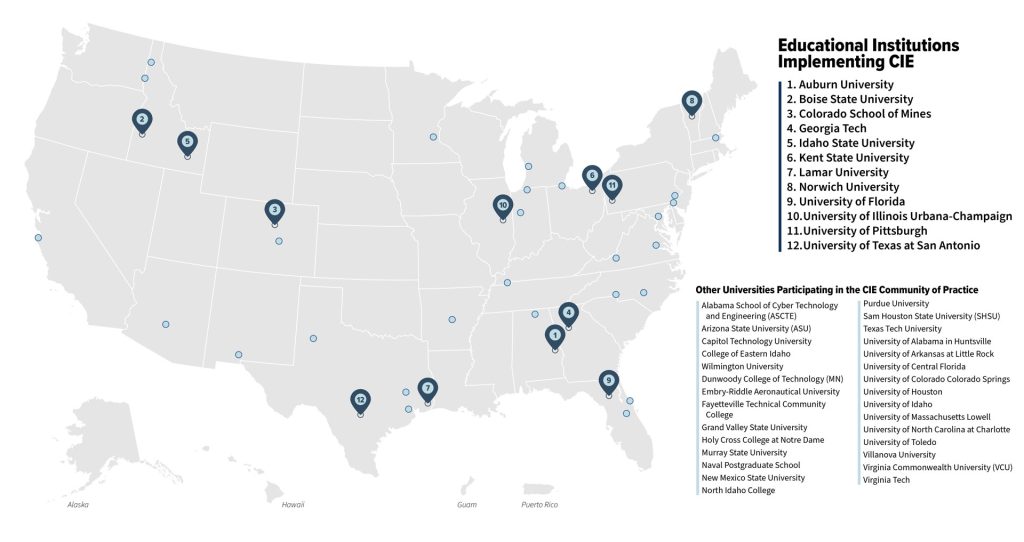Cyber-Informed Engineering
Managing Cyber Risk from Concept to Operation
Cyber-Informed Engineering (CIE) is a strategic initiative championed by Idaho National Laboratory (INL) to integrate cybersecurity into engineering practices for critical infrastructure. INL leads in implementing the national strategy by developing engineering tools, standards, and educational resources that prioritize cybersecurity in infrastructure design and operation.
INL’s key contributions to CIE include:
- A 200-member CIE Community of Practice for collaboration and knowledge exchange.
- A CIE Implementation Guide and Resource Library to facilitate the adoption of CIE practices.
- Partnerships with academic and industry stakeholders to incorporate CIE into engineering programs and infrastructure projects.
INL’s efforts ensure that infrastructure is designed with inherent defenses against cyber threats, enhancing the resilience of energy systems against potential attacks.
The Department of Energy (DOE) Office of Cybersecurity, Energy Security, and Emergency Response (CESER) sponsors INL CIE initiatives and coordinates the CIE program that includes INL; the National Renewable Energy Laboratory, and industry, academic, and other partners in support of the Department of Energy’s National Cyber-informed Engineering Strategy.
CIE Development Tools
Implementation Guide
Analysis Tool
Resource Library
Microgrid Analysis Tool
Battery Energy Storage Systems Analysis Tool
CIE Knowledge Hub
A repository for products and tools that INL’s Cyber-Informed Engineering program has produced under the Department of Energy’s Office of Cybersecurity, Energy Security, and Emergency Response.
CIE Development Tools
Implementation Guide
Resource Library
Microgrid Analysis Tool
Battery Energy Storage Systems Analysis Tool
Idaho and INL lead the charge in cyber-informed engineering to protect water systems
INL is integrating CIE into water systems to enhance resilience against cyber threats, with support from the Department of Energy and financial incentives from the Idaho Department of Environmental Quality, amid growing adoption and educational integration due to increasing cybersecurity risks from digital modernization.
National Cyber-Informed Engineering Strategy
The U.S. Department of Energy’s National CIE Strategy guides energy sector efforts to incorporate cybersecurity practices into the design life cycle of engineered systems to reduce cyber risk.
Strategy for Cyber-Physical Resilience: Fortifying Our Critical Infrastructure for a Digital World
The President’s Council of Advisors on Science and Technology (PCAST) is a federal advisory committee appointed by the president to provide science and technology advice. Comprising 28 distinguished leaders, PCAST advises on policies related to the economy, education, energy, environment, public health, security, racial equity, and more.
COME JOIN THE CIE COMMUNITY OF PRACTICE
Second Wednesday of January, April, July, and October 11 a.m. MT / 1 p.m. ET quarterly
Standards Working Group
First Wednesday at 9 a.m. MT / 11 a.m. ET monthly
Education Working Group
Third Wednesday at 9 a.m. MT / 11 a.m. ET monthly
Development Working Group
Fourth Wednesday at 9 a.m. MT / 11 a.m. ET monthly
Curriculum Resources
Teach CIE Principles at Leading US Engineering Universities
CIE Adoption in University Engineering Programs Report
The CIE Adoption in University Engineering Programs Report highlights nine academic partners who are incorporating CIE into their curricula through various approaches.
Curriculum Guide
The CIE Curriculum Guide provides a framework, guidance, and resources for incorporating CIE into university-level engineering programs and related educational activities. To accommodate a broad range of educational goals and approaches, this guide outlines several practical integration strategies, links to resources that can accelerate CIE adoption.
CIE Presentations
INL Testimony Select Committee on the Chinese Communist Party
What is Cyber-Informed Engineering?
Hosted by Idaho National Laboratory and the National Renewable Energy Laboratory, this webinar offers a CIE primer for energy companies, engineering firms, suppliers and manufactures, researchers, standards organizations, and government partners.
U.S. Senate Committee: Testimony
Securing U.S. critical water infrastructure in the energy sector requires preventing cyber threats by enhancing engineering and removing vulnerabilities. As hydropower systems modernize, increased support for threat identification and mitigation is essential. Cyber-informed engineering enables INL to ensure resilience against nation-state cyberattacks.
CIE Practitioner Workshop Videos
Check out our CIE Practitioner Workshop video playlist for expert insights on cybersecurity design. Learn how to apply Cyber-Informed Engineering principles to enhance the security and resilience of critical infrastructure.

